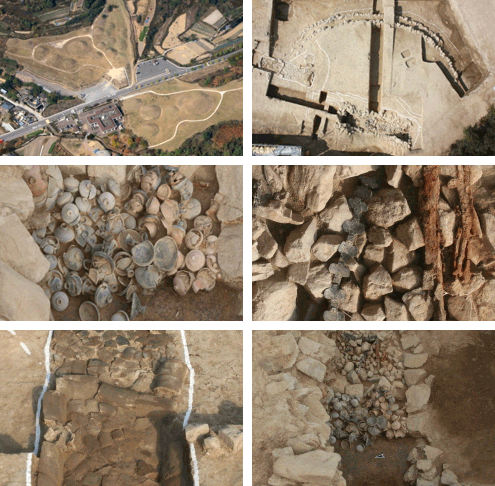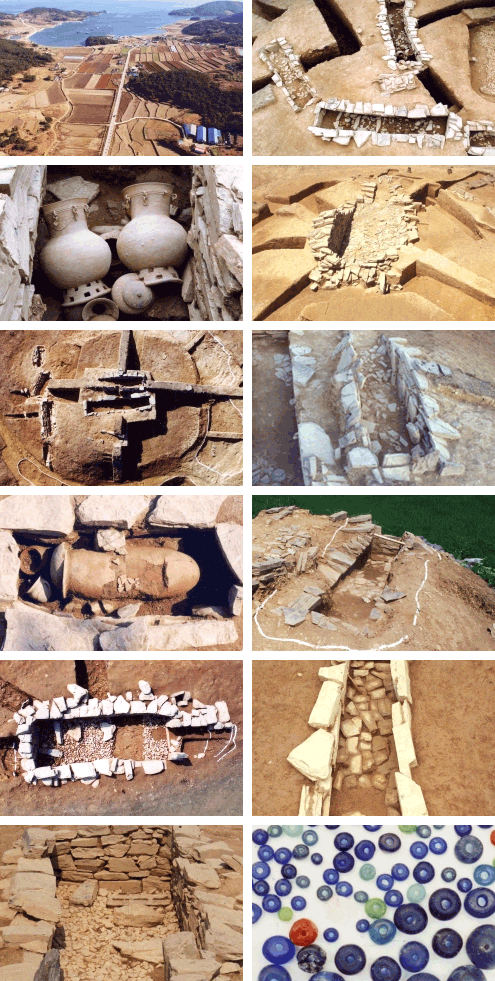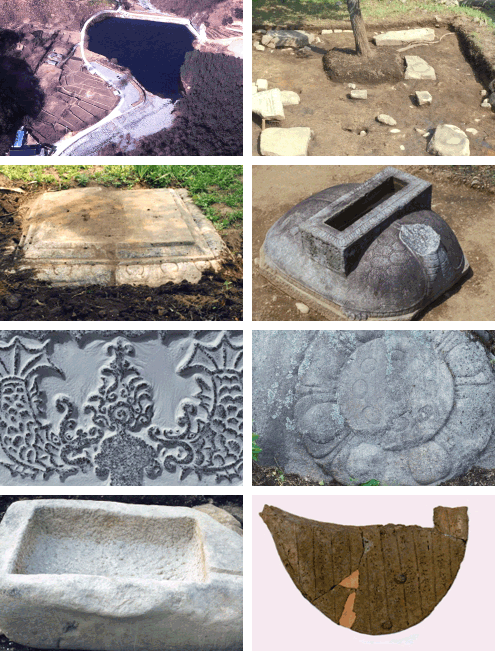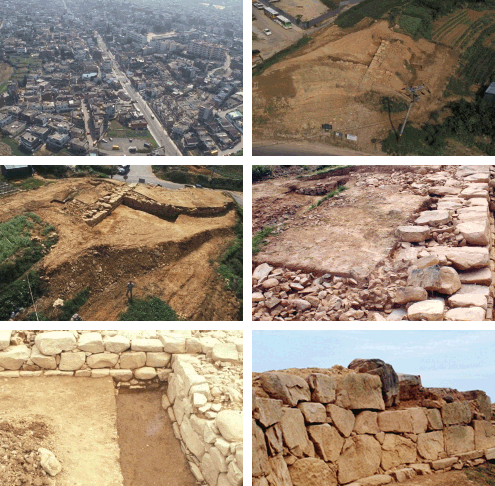Affiliated Institute
- Gyeongju National Research Institute of Cultural Heritage
- Buyeo National Research Institute of Cultural Heritage
- Gaya National Research Institute of Cultural Heritage
- Naju National Research Institute of Cultural Heritage
- Jungwon National Research Institute of Cultural Heritage
- Seoul National Research Institute of Cultural Heritage
- Wanju National Research Institute of Cultural Heritage
- Cultural Heritage Conservation Science Center
Discovery and Research of the Cultural Heritage of the Gaya Region
We plan and execute research projects of major prehistoric and historic sites in the region. In addition, we maintain and repair the national historic sites in the region, and survey new sites for potential designation as national historic sites. Our responsibilities also include protecting the historic sites from robbery or overdevelopment, which can cause serious damage or even destroy our historical artifacts, and inspecting emergency sites that may give rise to citizen complaints.
Ancient Tombs in Yeongsan, Changnyeong
| Heritage name | Ancient Tombs in Yeongsan, Changnyeong |
|---|---|
| Category | Three Kingdoms Period |
| Designation | Gyeongsangnam-do Monument |
| Survey period | 2010 ~ 2011 |
The Ancient Tombs in Yeongsan, Changnyeong, dispersed throughout the stretch of land running from Yeongsan-myeon, Dong-ri to area of Juksa-ri, constitute the most important cluster of ancient tombs in Changnyeong, along with the ancient tombs in Gyo-dong,
Songhyeon-dong and Gyeseong. In 2003, the Gyeongnam Research Institute of Cultural Heritage conducted a highly sophisticated investigation of the ground in the area and discovered fifty-three ancient tombs including a large-scale tomb measuring more than 20 meters in diameter. One of the tombs, however, was severely damaged, and since then we have been conducting primary excavations and the restoration of this tomb and its area in collaboration with Changnyeong-gun. The current excavation effort is the first attempt to excavate the Yeongsan tombs, a major cluster of Bihwa Gaya tumuli.
It is expected to provide valuable information and to shed light on the ancient culture and society of the Changnyeong region.
See A Related Image

Ancient Tombs in Gyo-dong, Changyeong
| Heritage name | Ancient Tombs in Gyo-dong, Changyeong |
|---|---|
| Category | Three Kingdoms Period |
| Designation | Historic Site |
| Survey period | 2009 ~ 2010 |
Excavations of the Ancient Tombs in Gyo-dong Changyeong site were resumed some eighteen years after the excavations conducted by Donga University in 1992 (Five tombs). The site was initially excavated in 1918-19 during the period of Japanese colonial rule, revealing nine tombs. The new series of excavations was undertaken in 2009 and 2010 as a new tomb was discovered during repair work on the parking lot of the site. The latest excavations disclosed a large stone chamber tomb with a mound measuring 19 meters in diameter. The tomb has a horizontal entrance and a thin quadrangular shape, with its major axis being 6.7 meters long. The interior of the tomb contains a closet for relics, a platform on which to lay the deceased, and a place of sacrificial burial. The occupant of the tomb was wearing a tubular jade and a silver belt, and was holding a sword with a ring pommel. Found in the closet containing the relics was an assortment of earthenware, harnessry, and fragments of human skeleton, all of which furnished us with valuable information on ancient burial rituals. In particular, a set comprising a silver belt and ornaments was excavated intact and whole, a rare addition to the inventory of ancient Korean artifacts. To the west of the tomb was a building site estimated to have been established in the late Joseon era (18th-19th c.). The front area of the site was covered with tiles (4 meters long and 1.5 meters wide), while the west side contained a square area of flat-tiled floor, indicating that the building was made for a special purpose.
See A Related Image

East and West Three-story Stone Pagoda in Suljeong-ri, Changnyeong
| Heritage name | East and West Three-story Stone Pagoda in Suljeong-ri, Changnyeong |
|---|---|
| Category | Unified Silla Period |
| Designation | East Pagoda (National Treasure); West Pagoda (Treasure) |
| Survey period | 2008 ~ 2009 |
Changnyeong inspected the three-story pagodas as part of the reparation and maintenance project of the area to assess the stability of their foundations and to find relics, if any. The base of the East Pagoda or Dongtap is composed of alternating layers of stone and soil, a style typical of Unified Silla. To the west of the pagoda, four building sites were identified, providing clues to the layout of the temple. In addition, a roof tile inscribed with the characters ‘Songnimsa’ and many other artifacts were found there. The base of the West Pagoda or Seotap, on the other hand, was built on a floor of clay, and is composed of alternating layers of sand and soil collected from the surrounding area. At the bottom of the pagoda, a set of bronze wind chimes was discovered.
See A Related Image

Seongsansanseong Fortress in Haman
| Heritage name | Seongsansanseong Fortress in Haman |
|---|---|
| Category | Three Kingdoms Period |
| Designation | Historic Site |
| Survey period | 1991 ~ Present |
Seongsansanseong Fortress in Haman is located on the top of Jonamsan Mountain, 139.4 meters above sea level and 2.5 kilometers south of Gaya-eup. It is a mountaintop fortress whose 1.4-kilometer-long wall surrounds the top of the mountain. The fortress is located in a strategic area of Ara Gaya in Haman. A group of high-mound tumuli for chief figures was found nearby in Dohang-ri and Malsan-ri, reflecting its status as Ara Gaya’s political and military hub. A series of fifteen excavations has been carried out since 1991 to identify the structure and characteristics of the fortress, during the course of which it was found that double-course masonry was used for the fortress, along with a triangular form of outer wall reinforcement associated with Silla fortress building techniques.
These excavations have also confirmed the shapes and locations of the fortress’s south and east gates and revealed valuable facts about its structure, including the drainage ducts, the outer wall reinforcement, and the abutments of the inner walls. The particularly significant findings, however, include a large-scale reservoir with stone embankments and wooden poles, and the use of the brush mattress technique (i.e. buyeop gongbeop) to artificially cover the bottom of the reservoir and the area around the eastern wall with vegetation. Around the eastern wall, where plant debris and other organic matter were embedded, small wooden artifacts such as clubs and combs were uncovered along with 280 wooden tablets, the largest collection found in Korea to date. On many of these wooden tablets are inscriptions of (Silla) bureaucratic titles (i.e. titles for local bureaucrats such as ilbeol or ilcheok) and geographical names, providing valuable materials for research on local administrative bodies of early Korea (And of Silla in particular). In addition, scroll spindles, brushes, and head shavers for monks were excavated from among the debris of plants and other organic matter.
See A Related Image

Ancient Tombs in Songhyeon-dong, Changnyeong
| Heritage name | Ancient Tombs in Songhyeon-dong, Changnyeong |
|---|---|
| Category | Three Kingdoms Period |
| Designation | Historic Site |
| Survey period | 2004 ~ 2008 |
The Ancient Tombs in Songhyeon-dong, Changnyeong form another important cluster of old tombs in Changnyeong, along with the tombs in Gyo-dong and Gyeseong. A large-scale tomb with a 20 meter-long mound and small- and medium-size tombs were found scattered along the southern slope of Mongmasanseong Fortress. The excavations carried out from 2004 to 2008 focused on Gourd-shaped Twin Tomb Nos. 6 and 7 and Nos. 15, 16, and 17. The investigation team also surveyed the area of Mongmasan and Hwawangsan Mountains near the old tombs, where they discovered another thirty-four tombs. Songhyeon-dong Tomb Nos. 6 and 7 are stone chamber tombs with a horizontal entrance, built around the late 5th to early 6th century. The excavations discovered that the tomb mounds were built outwards from the chambers in the center. More than 600 items of pottery and metal and wood works were found inside the chamber, including gold earrings, ring pommel swords, and a pile of arrows, as well as a collection of harnessry comprising saddles, horse gags, stirrups, belt hooks, gold buckles, horse strap pendants, and harness fittings.
In particular, a camphor tree coffin found intact in Tomb No. 7 is considered a very valuable acquisition among the archaeological community. Near the coffins, lacquer ware and gilt bronze belt hooks were found covered with leaves and other plant debris, and near the short walls of the chamber, pottery relics, including mounted dishes with a cover, were found placed in baskets, providing us with precious insights into the burial customs of the time. Meanwhile, from Tomb No. 15, a gilt bronze crown, a gold ring, gold beads, and an assortment of harnessry were unearthed, along with the skeletons of people thought to have been offered up as human sacrifices. The finding of these relics and remains led to a collaborative interdisciplinary research project, hitherto unprecedented in Korea, involving scholars from both humanities and sciences, such as archeology, forensic medicine, anatomy, genetics, chemistry, physics, and plastic art. The interdisciplinary research enabled us to reconstruct a person from the early Korea period and shed light on the burial customs of that time.
See A Related Image

Ancient Tombs in Naesan-ri, Goseong
| Heritage name | Ancient Tombs in Naesan-ri, Goseong |
|---|---|
| Category | Three Kingdoms Period |
| Designation | Historic Site |
| Survey period | 1997 ~ 2006 |
The Ancient Tombs in Naesan-ri, Goseong form a cluster of sixty-five or more medium- to large-size grave mounds situated on low hills (10~20 meters above sea level) near the coastal area of Jeokpoman Bay. It was a main burial site of the Sogaya ruling class during the Three Kingdoms Period. Seven years of excavations from 1997 to 2005 disclosed, to a certain extent, the identity and culture of the tomb owners and the structural characteristics of the tombs. At the center of each mound grave lay a vertical stone coffin or horizontal stone chamber (i.e. a tunnel stone chamber) containing the main occupant of the tomb, surrounded by a number of smaller stone or pottery coffins. The multi-coffin tomb is the most common tomb structure found in the Naesan-ri site. Since this tomb structure is also widely found at other ancient tomb sites in Goseong, such as those in Songhak-ri, Yuldae-ri and Yeondang-ri, it appears to have been a representative burial style of Sogaya. Graves with a large mound, such as Tomb No. 8, are unique to this region, and are also very common at the site. With these tombs, the main burial structure was laid on a flat foundation made of dark brown clay. Among the relics found in these tombs were not only mounted dishes with triangular holes and long-necked jars, typical late Gaya potteries of the western part of Gyeongsangnam-do, but also many Silla potteries such as mounted long-necked jars, and Baekje-style potteries like wide mouth jars with a hole. This indicates that the people of this polity, who built this cluster of tombs around the 6th century, were active interstate traders, taking full advantage of their coastal location.
See A Related Image

Jigoksa Temple Site in Sancheong
| Heritage name | Jigoksa Temple Site in Sancheong |
|---|---|
| Category | From United Silla to Joseon |
| Designation | Gyeonsangnam-do Monument |
| Survey period | January to June, 2002 |
Jigoksa Temple Site in Sancheong was a Buddhist temple believed to have been built during the reign of King Jinheung of Silla, and was designated as one of the five Zen mountain temples in the early Goryeo period. Located on the northern slope of Ungseokbong, a peak on Jirisan Mountain, the temple enjoyed a number of prosperous periods under famous monks like Jingwan (912~964) and Hyewol (10th~11th c.), and its Buddhist lights were continually illuminated (i.e. religious services were performed) well into the 19th century. Excavations of the site unearthed a concave eave-tile bearing the inscription Jigoksa Temple, thus clarifying the identity of the temple, as well as a sitting Buddha statue and a clay Buddha sculpture from the site of the three-roomed Golden Hall. Water tanks and turtle-shaped bases of steles from the Joseon Period were also found scattered about the area. In addition, part of a stone tower structure still stands on the slope behind the center of the Golden Hall, indicating a temple layout similar to the United Silla temples with a watchtower found in Namsan, Gyeongju. From the temple ruins on the solidly built foundation, roof tiles from the United Silla Period and roof tiles, bricks and ceramics from the Goryeo and Joseon Periods were unearthed. The excavated artifacts and the temple layout suggest that Jigoksa Temple was built no later than the United Silla Period and survived until the late Joseon Period.
See A Related Image

Unheungsa Temple Site in Ulsan
| Heritage name | Unheungsa Temple Site in Ulsan |
|---|---|
| Category | United Silla ~ Joseon |
| Designation | - |
| Survey period | July to December 2001 |
Unheungsa Temple Site in Ulsan, located in the eastern valley of Jeongjoksan between Yangsan-si and Eonyang-eup, is said to have been founded by Great Priest Wonhyo during the reign of King Jinpyeong of Silla. The temple was famous for woodblock printing in the Joseon Period, and some 670 woodblocks of 16 types are still preserved in Yangsan’s Tongdosa Temple, highly regarded for its historical value.
Excavations were limited to the area where the Golden Hall was believed to have been, but seven building sites were identified along with the ruins of masonry structures and drainage channels estimated to date back to the mid-Joseon period. In addition, 180 fragments of artifacts - including roof tiles, bricks, ceramics, metal works, and Buddha statue fragments - were discovered there. Among the artifacts was a concave eave-tile inscribed with the temple’s name, Unheung, and edge-tiles and stone artifacts marked with era names or sexagenarian years that help us to identify the period and characteristics of the ruins. At the east-facing building site, believed to have been the temple’s Golden Hall, it was possible to find traces of renovation of a building with three front and two side rooms and another with three front and three side rooms. Another large-scale building site was found with most of its ondol frame (Ondol: traditional Korean under-the-floor heating system) and thin stone platforms still intact. Although most of the relics found at the Unheungsa Temple site originate from the Joseon Period, a few - such as roof tiles and celadon potteries - are from the late Unified Silla and Goryeo periods, hinting at the temple’s long existence.
See A Related Image

Prehistoric Site in Sangnam, Changwon
| Heritage name | Prehistoric Site in Sangnam, Changwon |
|---|---|
| Category | Bronze Age |
| Designation | - |
| Survey period | January 1999 ~ February 2000 |
The stretch of land extending from Sangnam-dong to Towol-dong, located in the center of the Changwon Basin, contains extensive prehistoric remains including dolmens and shell mounds. Four series of excavations were conducted at the site in preparation for the development of the Sangnam Commercial District. The Sangnam Prehistoric Site consists of the vestigial remains of a bronze-age religious ritual venue and a double-layered pit house, a form of prehistoric structure rarely found in Korea or elsewhere. Like the Dolmens in Sangnam (Surveyed in 1998) located just north of this site, it is considered a complex of massive prehistoric ruins. The ritual site, located near the river, is a type of waterside ritual structure that uses natural ditches made by streams or rivers. Discarded earthenware objects with a round hole on the bottom, crushed earthenware bowls, fishing-net sinkers and fractured stone implements were collected from the site, shedding new light on rituals performed in the Bronze Age. The round-shaped pit house lot is relatively small, suggesting that it was dug not for defensive purposes but to mark the boundaries for a certain place. The relics excavated at the site also indicate that the site probably had a religious function. In addition, the shapes of the potteries - deep bowls and bowls with a knob handle - and the forms of the stone tools - those of arrowheads, polished stone axes, and crescent-shaped knives - suggest that the settlements were formed between the sixth and fourth centuries B.C., overlapping in time with the Dolmens in Sangnam. The Sangnam Prehistoric Site, along with the neighboring dolmens, is expected to furnish us with valuable academic insights into the prehistoric culture of the region.
See A Related Image

Dansoksa Temple Site in Sancheong
| Heritage name | Dansoksa Temple Site in Sancheong |
|---|---|
| Category | United Silla |
| Designation | Historic Site |
| Survey period | October to December 1999 |
The Dansoksa Temple Site in Sancheong consists of the ruins of a Unified Silla temple located on the southern slope of Ungseokbong, a peak of Jirisan Mountain. The presumed temple grounds are now occupied mostly by private residences and farmland, with just a three-story stone pagoda (National Treasure) and a stone banner pole base (National Treasure) remaining as vestiges of the old Buddhist temple. Dansoksa was supposedly built by Yi Sun during the reign of King Gyeongdeok of Unified Silla (r. 742~765) and was later renovated by Sin Chung, although the remaining three-story pagoda is estimated to have been built in the early 9th century. The excavations conducted in the redevelopment area north of the pagoda revealed two private housing sites along with the remains of ceramics, roof tiles, and small Buddha statues.
See A Related Image

Military Headquarters in Ulsan
| Heritage name | Military Headquarters in Ulsan |
|---|---|
| Category | Joseon |
| Designation | Historic Site |
| Survey period | August to October 1999 |
Military Headquarters in Ulsan was a fortress of the governor of Gyeongsangjwa-do Province during the Joseon Dynasty. It was built in the 17th year of the reign of King Taejong (1417) and remained in use until the mid-to-late 19th century. The fortress stands on a low hill less than 45 meters above sea level, on the west side of the Dongcheon stream running between Chisullyeong (765 meters above sea level) in the northwest and Dongdaesan (444 meters above sea level) in the east. Its location is geographically advantageous as it enables observation of the path from the coast up to Gyeongju. Excavations of the north gate site have uncovered a main wall, an outer wall enclosing the gate site, and remnants of facilities believed to be a moat. In addition, twenty-four fragments of artifacts - mostly potteries, ceramics and tiles - were collected from the site. Although the north gate no longer exists, the bottom half of the main fortress wall on the east side has survived, semi-circled by the outer wall, a crucial defense structure. Both the main and outer walls were double-coursed stone walls, and the gap of 7 - 8 meters between the inner and outer courses was filled with rubble to strengthen the walls. In addition, a stone structure left only with two to three layers of stones, which may have been part of the foundations of a moat, was found approximately 16 meters from the main wall. Military Headquarters of Ulsan is a typical town fortress of the Joseon Period. The castle survived longer than others of its kind thanks to its superior location and is classed as a valuable historical heritage.
See A Related Image



